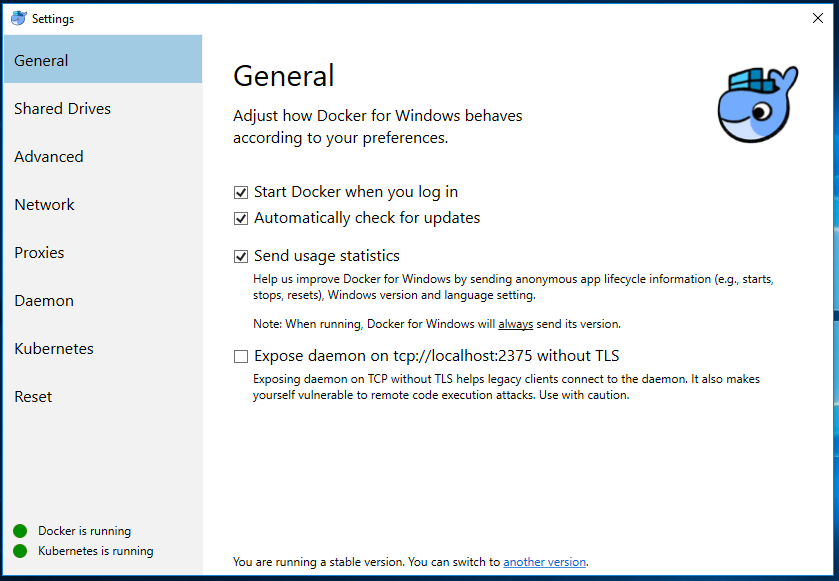Docker Vm Download
Chocolatey is software management automation for Windows that wraps installers, executables, zips, and scripts into compiled packages. Chocolatey integrates w/SCCM, Puppet, Chef, etc. Chocolatey is trusted by businesses to manage software deployments. Feb 17, 2021 The host.docker.internal and vm.docker.internal DNS entries now resolve. We removed hard-coded IP addresses: it now dynamically discovers the IP allocated by macOS. Osxfs file sharing now works. We made a configuration change that should improve disk performance. The Restart option in the Docker menu works.
No one enjoys waiting, and waiting for your software to build and tests to run isn’t fun either—in fact, it’s quite expensive.And if you’re building your Docker image in a CI system like GitHub Actions with ephemeral runners—where a new environment gets spinned up for every build—by default your builds are going to be extra slow.
Java Vm Download
In particular, when you spin up a new VM with a new Docker instance, the cache is empty, so when you run the Docker build your image has to be built from scratch.
Luckily, Docker includes some features to allow you to warm up the cache, by pulling previous versions of the image.And the newer BuildKit build system improves this even further—but also requires some changes, otherwise caching will stop working.
Docker Machine Download Windows 7
Let’s see how you can speed up your Docker builds in CI with classic Docker, and then the improvements (and pitfall) provided by BuildKit.
Why building Docker images in CI can be slow
When you rebuild an existing image, Docker can look in its local cache for existing layers and reuse those if nothing has changed.This allows for faster builds.
However, in many cases CI runs on a new virtual machine or environment on every run.For example, whenever you run a task in GitHub Actions by default you will be using a new virtual machine.A new virtual machine means a new Docker install, and a new Docker install has an empty cache.
An empty cache means your image will be rebuilt from scratch—and that’s slow.
Speeding up CI builds in classic Docker

In order to make it easier to test things, I’m going to spin up a Docker registry on my computer, equivalent to hub.docker.com or a cloud image registry:
Here’s the Dockerfile we’re going to be building; it’s set up so that if the code changes but requirements.txt is the same, Docker will be able to use the cached layer with the installed dependencies:

Note: Outside the very specific topic under discussion, the Dockerfiles in this article are not examples of best practices, since the added complexity would obscure the main point of the article.
To ensure you’re writing secure, correct, fast Dockerfiles, consider my Python on Docker Production Handbook, which includes a packaging process and >70 best practices.
In order to simulate building in an ephemeral, newly created VM, we’re going to use the following script to clear the cache in between builds:
Here’s out first pass at a build script:
Let’s run this a couple of times; if caching was working correctly this would run really quickly the second time:
As expected, because we’re simulating a new VM with an empty cache, the second build is no faster.
Warming the cache
In order to speed up the builds, we need to “warm” the cache.In classic Docker we do this by:
pulling the image.- Using the
--cache-fromflag to telldocker buildto use the pulled image as a source of cached layers.
We modify build.sh appropriately:
Now if we run the script:
That’s a lot faster!
BuildKit: faster, but with pitfalls
Oracle Virtualbox Download
Let’s consider how classic caching works: we need to retrieve the whole image.If for example our code has changed, we don’t actually need to download the layer where the code is installed, since we’re not going to reuse it.

Ideally we could just point Docker at the image registry as part of the build, and it would only download the layers it was actually going to reuse.Technically this was possible with classic Docker, but apparently it was buggy and unreliable.
With BuildKit, the new build system for Docker, this is a built-in feature: you can skip the docker pull and just have the build pull the layers it needs.
There is a pitfall, though: by default BuildKit doesn’t include the information needed to reuse images for caching.In order to do so, you have to add an extra flag, --build-arg BUILDKIT_INLINE_CACHE=1, otherwise caching won’t work at all, whether or not you’ve pull Illustrator for mac free trial. ed.
Here’s our new build script:

Let’s try it out:
The first build doesn’t use any of the classic Docker caching so it takes the full amount of time.The second build is sped up—but we didn’t have to do an explicit pull!
Docker Machine Download Windows
In many cases that can speed up builds, as BuildKit can pull only the layers it needs.If you’re using multi-stage builds BuildKit will do some of the build in parallel, giving more opportunities for a speed-up.
Go faster!
Docker Vm Download Free
If you’re building Docker images in CI, and each CI run starts with an empty cache, make sure you’re using these techniques to keep your cache warm.You’ll get faster builds, save a little money, and save a little CO₂ too.
